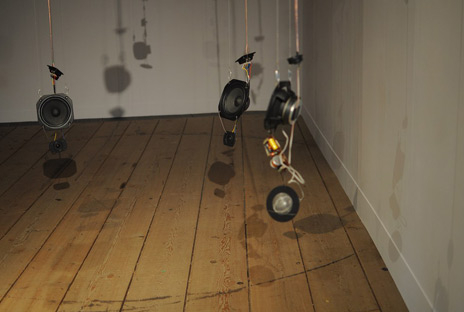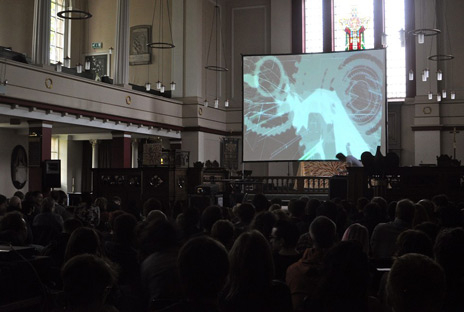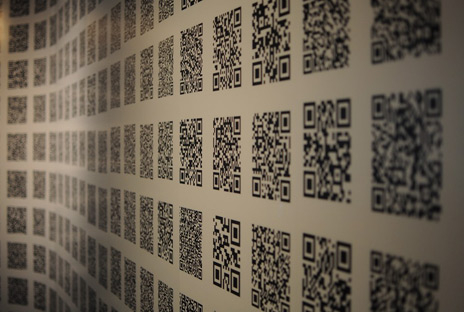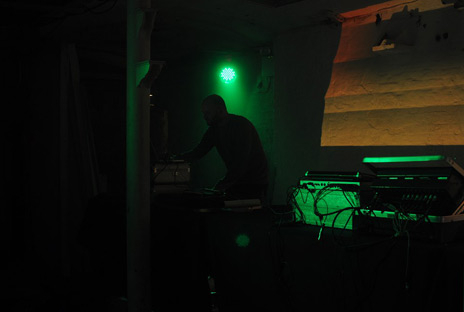- As technology develops, it goes through a series of what are called Readiness Levels. Levels one and two refer to the stages of blue-sky thinking, which is pure idea generation. Things like commercial viability are left to later levels. After this year's event, it seems that FutureEverything is a festival that operates in the spirit of Levels one and two. Formerly called FutureSonic, and now in its 17th year, this year's theme was FutureEverybody, with the conference and art exploring concepts concerning the development of participatory culture and technology. Meanwhile, the musical events, and indeed the methods used by a number of the musicians, felt unflinchingly modern.
 The conference itself was often fascinating, and almost always relevant. It included the exploration of open source culture, hacking, and various philosophical paradigms related to the internet. There was a strong theme of data, encompassing how it can be processed, used and presented. There were talks on how the immense amount of data from Twitter or Facebook might be usefully collated. There was plenty for engineers too—from a practical session writing code to scrape data from the web to a captivating talk on designing future cities using data from sensors embedded in our everyday lives. The talks felt largely academic, rather than actively constructive. But that also meant that it was nothing short of mind-expanding at times, providing a wealth of fresh and creative thinking.
The conference itself was often fascinating, and almost always relevant. It included the exploration of open source culture, hacking, and various philosophical paradigms related to the internet. There was a strong theme of data, encompassing how it can be processed, used and presented. There were talks on how the immense amount of data from Twitter or Facebook might be usefully collated. There was plenty for engineers too—from a practical session writing code to scrape data from the web to a captivating talk on designing future cities using data from sensors embedded in our everyday lives. The talks felt largely academic, rather than actively constructive. But that also meant that it was nothing short of mind-expanding at times, providing a wealth of fresh and creative thinking.
 The festival's art component seemed to have a particularly strong sense of purpose. The internet, video streaming and other technologies were used to create a range of imaginative and interactive games and activities around the streets of Manchester. The art in the exhibition was often strongly centred around generative methods, using QR codes, RFID tags and, of course, numerous collaborative tools to make various statements about the digital world. The craft fair, at a restored Edwardian swimming pool, showcased a spectrum of DIY culture. It included a range of electronic curiosities, methods like 3D printing and a fanzine section, along with some create-your-own activities.
Music-wise, the Tri Angle night showcased a highly regarded record label that operates in a particularly unique space. Holy Other had a well-chiselled sound palette of digital tones and desperate, cut-up vocals, while The Haxan Cloak was a lot more drone, but it all had the same incense-wreathed atmosphere. Matthew Herbert actually has a formal agenda for his highly conceptual style of sampled art, and his One Pig project has made an especially loud statement since its release, resounding among animal rights groups as well as music fans. The Sty Harp was reeled out, with its creator, Yann Seznek, wildly manipulating it with a gleeful look on his face, quite in contrast to Herbert's more serious demeanour. The smell from the pork being cooked live on stage was unavoidable and also heard through the theatre. Grunting 4/4 rhythms moved through to slathering, earthy offbeat numbers, but always in keeping with the dirt and thickness of the hog whose recordings were used to make the album.
The festival's art component seemed to have a particularly strong sense of purpose. The internet, video streaming and other technologies were used to create a range of imaginative and interactive games and activities around the streets of Manchester. The art in the exhibition was often strongly centred around generative methods, using QR codes, RFID tags and, of course, numerous collaborative tools to make various statements about the digital world. The craft fair, at a restored Edwardian swimming pool, showcased a spectrum of DIY culture. It included a range of electronic curiosities, methods like 3D printing and a fanzine section, along with some create-your-own activities.
Music-wise, the Tri Angle night showcased a highly regarded record label that operates in a particularly unique space. Holy Other had a well-chiselled sound palette of digital tones and desperate, cut-up vocals, while The Haxan Cloak was a lot more drone, but it all had the same incense-wreathed atmosphere. Matthew Herbert actually has a formal agenda for his highly conceptual style of sampled art, and his One Pig project has made an especially loud statement since its release, resounding among animal rights groups as well as music fans. The Sty Harp was reeled out, with its creator, Yann Seznek, wildly manipulating it with a gleeful look on his face, quite in contrast to Herbert's more serious demeanour. The smell from the pork being cooked live on stage was unavoidable and also heard through the theatre. Grunting 4/4 rhythms moved through to slathering, earthy offbeat numbers, but always in keeping with the dirt and thickness of the hog whose recordings were used to make the album.
 Elsewhere, Krautrock legend Dieter Moebius soundtracked Fritz Lang's silent film Metropolis. It was an experience of being submerged in antique, pre-digital futurism. Moebius scattered arrhythmic, atonal grains of electronic sound around an alien soundscape, marrying its feel with the movie's scenes imaginatively and sublimely. Tim Hecker performed in the same church the night before, and was even more amazing. In the same style as his last album, Ravedeath, 1972, which was recorded in a church in Rejkjavik, he ran sounds played on the pipe organ through a Max/MSP patch and distortion pedals. It created a moving and intensely lucid texture of shifting ambient noise, inducing a meditative state and a religious atmosphere, with heads bowed along the pews.
Amon Tobin headlined, with his renowned ISAM Live show. 3D projection mapping is still a nascent technology and, to date, this show is probably the most prominent example of an underground electronic musician utilising the extraordinary medium. The blocks and visual scenes were arranged differently than those in previous shows but it was, once again, a remarkable experience, both aurally and visually. The hall itself had quite significant ambient lighting from a bar down one side and bright emergency exit lights, and this reduced the show's impact somewhat—unfortunately unavoidable since it was the only available venue able to stage the show in the city. It was still exhilarating, though; you just had to move a bit further forward.
Elsewhere, Krautrock legend Dieter Moebius soundtracked Fritz Lang's silent film Metropolis. It was an experience of being submerged in antique, pre-digital futurism. Moebius scattered arrhythmic, atonal grains of electronic sound around an alien soundscape, marrying its feel with the movie's scenes imaginatively and sublimely. Tim Hecker performed in the same church the night before, and was even more amazing. In the same style as his last album, Ravedeath, 1972, which was recorded in a church in Rejkjavik, he ran sounds played on the pipe organ through a Max/MSP patch and distortion pedals. It created a moving and intensely lucid texture of shifting ambient noise, inducing a meditative state and a religious atmosphere, with heads bowed along the pews.
Amon Tobin headlined, with his renowned ISAM Live show. 3D projection mapping is still a nascent technology and, to date, this show is probably the most prominent example of an underground electronic musician utilising the extraordinary medium. The blocks and visual scenes were arranged differently than those in previous shows but it was, once again, a remarkable experience, both aurally and visually. The hall itself had quite significant ambient lighting from a bar down one side and bright emergency exit lights, and this reduced the show's impact somewhat—unfortunately unavoidable since it was the only available venue able to stage the show in the city. It was still exhilarating, though; you just had to move a bit further forward.
 Around the corner, Levon Vincent and Marcel Dettmann played in another university campus building. Vincent's weighty deep house and Dettmann's varied style of techno should have been good to listen to anywhere. Again, though, it was the venue in the city that made the most sense, due to its location this time, but it felt largely functional and atmosphere wasn't really at a premium, making for a bit of an anticlimax after four days of inspiration.
Around the corner, Levon Vincent and Marcel Dettmann played in another university campus building. Vincent's weighty deep house and Dettmann's varied style of techno should have been good to listen to anywhere. Again, though, it was the venue in the city that made the most sense, due to its location this time, but it felt largely functional and atmosphere wasn't really at a premium, making for a bit of an anticlimax after four days of inspiration.
 The conference itself was often fascinating, and almost always relevant. It included the exploration of open source culture, hacking, and various philosophical paradigms related to the internet. There was a strong theme of data, encompassing how it can be processed, used and presented. There were talks on how the immense amount of data from Twitter or Facebook might be usefully collated. There was plenty for engineers too—from a practical session writing code to scrape data from the web to a captivating talk on designing future cities using data from sensors embedded in our everyday lives. The talks felt largely academic, rather than actively constructive. But that also meant that it was nothing short of mind-expanding at times, providing a wealth of fresh and creative thinking.
The conference itself was often fascinating, and almost always relevant. It included the exploration of open source culture, hacking, and various philosophical paradigms related to the internet. There was a strong theme of data, encompassing how it can be processed, used and presented. There were talks on how the immense amount of data from Twitter or Facebook might be usefully collated. There was plenty for engineers too—from a practical session writing code to scrape data from the web to a captivating talk on designing future cities using data from sensors embedded in our everyday lives. The talks felt largely academic, rather than actively constructive. But that also meant that it was nothing short of mind-expanding at times, providing a wealth of fresh and creative thinking.
 The festival's art component seemed to have a particularly strong sense of purpose. The internet, video streaming and other technologies were used to create a range of imaginative and interactive games and activities around the streets of Manchester. The art in the exhibition was often strongly centred around generative methods, using QR codes, RFID tags and, of course, numerous collaborative tools to make various statements about the digital world. The craft fair, at a restored Edwardian swimming pool, showcased a spectrum of DIY culture. It included a range of electronic curiosities, methods like 3D printing and a fanzine section, along with some create-your-own activities.
Music-wise, the Tri Angle night showcased a highly regarded record label that operates in a particularly unique space. Holy Other had a well-chiselled sound palette of digital tones and desperate, cut-up vocals, while The Haxan Cloak was a lot more drone, but it all had the same incense-wreathed atmosphere. Matthew Herbert actually has a formal agenda for his highly conceptual style of sampled art, and his One Pig project has made an especially loud statement since its release, resounding among animal rights groups as well as music fans. The Sty Harp was reeled out, with its creator, Yann Seznek, wildly manipulating it with a gleeful look on his face, quite in contrast to Herbert's more serious demeanour. The smell from the pork being cooked live on stage was unavoidable and also heard through the theatre. Grunting 4/4 rhythms moved through to slathering, earthy offbeat numbers, but always in keeping with the dirt and thickness of the hog whose recordings were used to make the album.
The festival's art component seemed to have a particularly strong sense of purpose. The internet, video streaming and other technologies were used to create a range of imaginative and interactive games and activities around the streets of Manchester. The art in the exhibition was often strongly centred around generative methods, using QR codes, RFID tags and, of course, numerous collaborative tools to make various statements about the digital world. The craft fair, at a restored Edwardian swimming pool, showcased a spectrum of DIY culture. It included a range of electronic curiosities, methods like 3D printing and a fanzine section, along with some create-your-own activities.
Music-wise, the Tri Angle night showcased a highly regarded record label that operates in a particularly unique space. Holy Other had a well-chiselled sound palette of digital tones and desperate, cut-up vocals, while The Haxan Cloak was a lot more drone, but it all had the same incense-wreathed atmosphere. Matthew Herbert actually has a formal agenda for his highly conceptual style of sampled art, and his One Pig project has made an especially loud statement since its release, resounding among animal rights groups as well as music fans. The Sty Harp was reeled out, with its creator, Yann Seznek, wildly manipulating it with a gleeful look on his face, quite in contrast to Herbert's more serious demeanour. The smell from the pork being cooked live on stage was unavoidable and also heard through the theatre. Grunting 4/4 rhythms moved through to slathering, earthy offbeat numbers, but always in keeping with the dirt and thickness of the hog whose recordings were used to make the album.
 Elsewhere, Krautrock legend Dieter Moebius soundtracked Fritz Lang's silent film Metropolis. It was an experience of being submerged in antique, pre-digital futurism. Moebius scattered arrhythmic, atonal grains of electronic sound around an alien soundscape, marrying its feel with the movie's scenes imaginatively and sublimely. Tim Hecker performed in the same church the night before, and was even more amazing. In the same style as his last album, Ravedeath, 1972, which was recorded in a church in Rejkjavik, he ran sounds played on the pipe organ through a Max/MSP patch and distortion pedals. It created a moving and intensely lucid texture of shifting ambient noise, inducing a meditative state and a religious atmosphere, with heads bowed along the pews.
Amon Tobin headlined, with his renowned ISAM Live show. 3D projection mapping is still a nascent technology and, to date, this show is probably the most prominent example of an underground electronic musician utilising the extraordinary medium. The blocks and visual scenes were arranged differently than those in previous shows but it was, once again, a remarkable experience, both aurally and visually. The hall itself had quite significant ambient lighting from a bar down one side and bright emergency exit lights, and this reduced the show's impact somewhat—unfortunately unavoidable since it was the only available venue able to stage the show in the city. It was still exhilarating, though; you just had to move a bit further forward.
Elsewhere, Krautrock legend Dieter Moebius soundtracked Fritz Lang's silent film Metropolis. It was an experience of being submerged in antique, pre-digital futurism. Moebius scattered arrhythmic, atonal grains of electronic sound around an alien soundscape, marrying its feel with the movie's scenes imaginatively and sublimely. Tim Hecker performed in the same church the night before, and was even more amazing. In the same style as his last album, Ravedeath, 1972, which was recorded in a church in Rejkjavik, he ran sounds played on the pipe organ through a Max/MSP patch and distortion pedals. It created a moving and intensely lucid texture of shifting ambient noise, inducing a meditative state and a religious atmosphere, with heads bowed along the pews.
Amon Tobin headlined, with his renowned ISAM Live show. 3D projection mapping is still a nascent technology and, to date, this show is probably the most prominent example of an underground electronic musician utilising the extraordinary medium. The blocks and visual scenes were arranged differently than those in previous shows but it was, once again, a remarkable experience, both aurally and visually. The hall itself had quite significant ambient lighting from a bar down one side and bright emergency exit lights, and this reduced the show's impact somewhat—unfortunately unavoidable since it was the only available venue able to stage the show in the city. It was still exhilarating, though; you just had to move a bit further forward.
 Around the corner, Levon Vincent and Marcel Dettmann played in another university campus building. Vincent's weighty deep house and Dettmann's varied style of techno should have been good to listen to anywhere. Again, though, it was the venue in the city that made the most sense, due to its location this time, but it felt largely functional and atmosphere wasn't really at a premium, making for a bit of an anticlimax after four days of inspiration.
Around the corner, Levon Vincent and Marcel Dettmann played in another university campus building. Vincent's weighty deep house and Dettmann's varied style of techno should have been good to listen to anywhere. Again, though, it was the venue in the city that made the most sense, due to its location this time, but it felt largely functional and atmosphere wasn't really at a premium, making for a bit of an anticlimax after four days of inspiration.